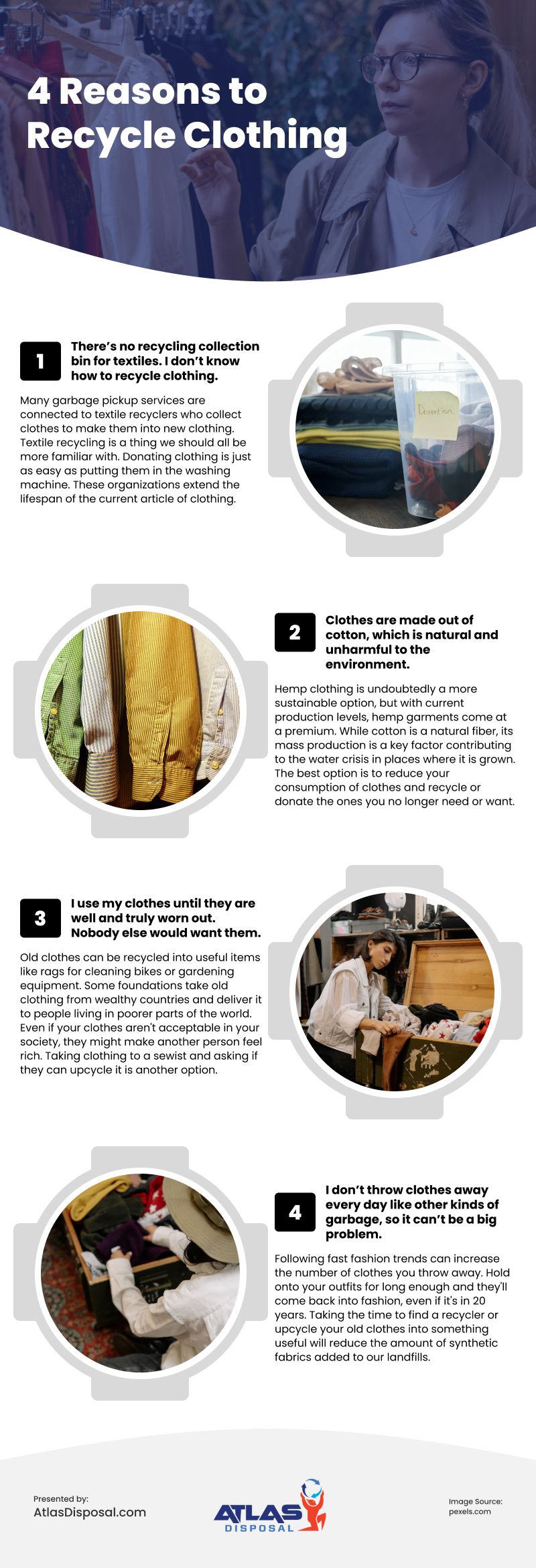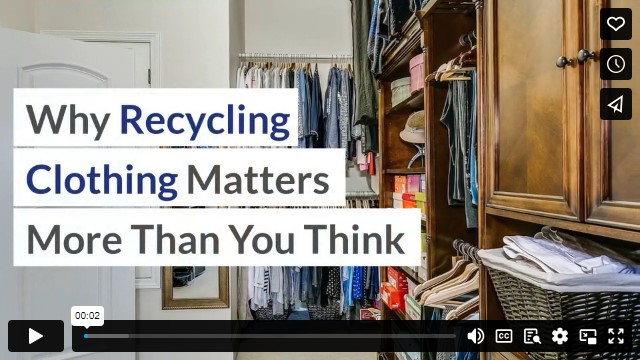Why Recycling Clothing Matters More Than You Think
Recycling isn’t a new concept and neither is clothing. Putting the two together and recycling clothing might not be quite as familiar, however. Some reasons for this lack of attention to recycling clothing might include the following:
- There’s no recycling collection bin for textiles. I don’t know how to recycle clothing.
- Clothes are made out of cotton, which is natural and unharmful to the environment.
- I use my clothes until they are truly worn out. Nobody else would want them.
- I don’t throw clothes away every day like other kinds of garbage, so it can’t be a big problem.
If these objections sound like you or your friends, take a minute to reconsider your assumptions and keep reading to learn why clothing recycling is important and find out about the many options for reducing clothing waste.
First, let’s begin with some statistics from the Environment Center at the University of Colorado in Boulder:
- Textile waste accounts for 5% of all landfills
- Only 15% of the clothing that is produced is recycled or donated
These are not the most inspiring numbers. We can do better. Most modern synthetic materials are made with fossil fuels and degrade on a similar timescale to plastic. They can last over 200 years in landfills before they get broken down.
Secondly, let’s take a look at each of the sentiments mentioned at the start of this article to see what we can uncover:
There’s no recycling collection bin for textiles. I don’t know how to recycle clothing.
It’s true; there aren’t collection bins for textiles like there are for plastic, paper, and cans. However, many garbage pickup services are connected to textile recyclers who collect clothes to make them into new clothing.
Reaching out to these companies takes a little more effort than filling up the bins at home, but normally is a much smoother process than most people think it will be. Also, you’ll likely only to need to reach out once or twice a year, so the overall effort required isn’t that much.
While textile recycling is a thing we should all be more familiar with, most people do know about second-hand stores that welcome clothing donations. These organizations are better than giving your old clothes to textile recyclers because they extend the lifespan of the current article of clothing. Donating clothing is just as easy as putting them in the washing machine.
Clothes are made out of cotton, which is natural and unharmful to the environment.
While many clothes are partially made out of cotton, these days, most are made out of synthetic textiles. Synthetic materials are made with fossil fuels and are, for all intents and purposes, the same as plastic. They break down into microplastics that end up in the oceans, the tops of mountains, and our bodies.
But what about 100% cotton? While cotton is a natural fiber, its mass production is a key factor contributing to the water crisis in places where it is grown. Hemp clothing is undoubtedly a more sustainable option, but with current production levels, hemp garments come at a premium. The best option is to reduce your consumption of clothes and recycle or donate the ones you no longer need or want.
I use my clothes until they are well and truly worn out. Nobody else would want them.
While second-hand stores might not accept them, it doesn’t mean they deserve to be thrown into a landfill. Consider using old shirts as rags for cleaning bikes or gardening equipment. Old rags come in handy for greasy spills, cleaning the BBQ, and a thousand other tasks.
Taking clothing to a sewist and ask if they have any ability to upcycle the garment is another option, like creating an armchair cover by sewing together a bunch of old-fashioned ties. Some foundations take old clothing from wealthy countries and deliver it to people living in much poorer conditions. Even if your clothes aren’t acceptable in your society, they might make another person feel rich.
I don’t throw clothes away every day like other kinds of garbage, so it can’t be a big problem.
5% of landfills, remember. Whole outfits don’t get thrown away very often, but what about odd socks? Throwing these away when they’ve lost their mate isn’t something most of us think twice about. Following fast fashion trends can also hugely increase the number of clothes you throw away. Hold onto your outfits for long enough, and they’ll come back into fashion, even if it’s in 20 years.
While the various reasons for not recycling clothing may not be all wrong, there are better options. Taking the time to find a recycler or upcycle your old clothes into something useful will reduce the amount of synthetic fabrics added to our landfills and microplastics polluting our planet.
Infographic
Recycling used garments can have a significant and beneficial effect on the surrounding ecosystem. It lessens the load on landfills and contributes to preserving materials that would have been thrown away otherwise. Recycling also stops used clothing from polluting waterways and contributing to the emission of dangerous pollutants into our planet’s atmosphere.


